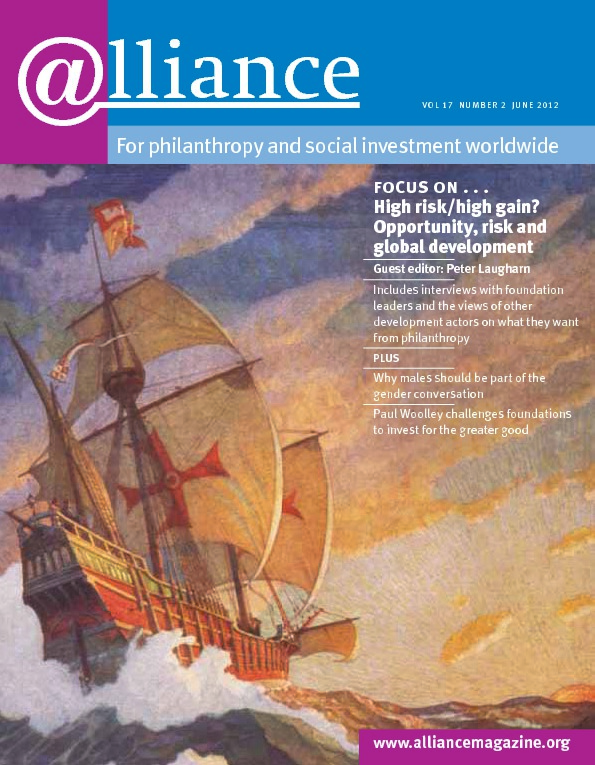Private foundations are investing increasing amounts in efforts to tackle the causes and consequences of extreme poverty in low-income countries, but we are still extremely small players compared to government donor agencies and the international financial institutions. Yet foundations have several comparative advantages, including the ability to respond quickly and flexibly and to take risks that public funders are unable or unwilling to take.
 The William and Flora Hewlett Foundation’s Guiding Principles state that the foundation ‘focuses on the most serious problems facing society where risk capital, responsibly invested, may make a difference over time’. Our grantmaking reflects the board’s and staff’s considerable tolerance (even appetite) for risk – risks that ambitious strategies will fail to achieve their objectives, that fragile organizations may collapse, or that unexpected developments, ranging from political change to civil war, may disrupt our plans.
The William and Flora Hewlett Foundation’s Guiding Principles state that the foundation ‘focuses on the most serious problems facing society where risk capital, responsibly invested, may make a difference over time’. Our grantmaking reflects the board’s and staff’s considerable tolerance (even appetite) for risk – risks that ambitious strategies will fail to achieve their objectives, that fragile organizations may collapse, or that unexpected developments, ranging from political change to civil war, may disrupt our plans.
Hewlett’s approach to risk
In each of our programme areas, we consider risk within a framework of expected return analysis, which takes into account the magnitude of the benefit if the strategy succeeds, the likelihood of success, and the cost of pursuing the strategy. This approach captures the fact that a risky philanthropic venture with a small likelihood of success is justified by very high benefits if it does succeed. For example, more than a quarter of our annual grants budget supports advocacy for policies to reduce global warming – a strategy where all philanthropy combined has a relatively low likelihood of success, but one that we believe will prevent catastrophic harm if it succeeds.
 In addition to being risky, initiatives of this sort typically require a long-term view and provision of funding for ‘upstream’ activities such as data collection, policy research and building technical and advocacy capacity. Results can be expected only 5, 10 or even 20 years on, and the line between what we fund and the ultimate achievements is rarely a straight one. This calls for patience and tolerance for ambiguity as well as a willingness to take risk.
In addition to being risky, initiatives of this sort typically require a long-term view and provision of funding for ‘upstream’ activities such as data collection, policy research and building technical and advocacy capacity. Results can be expected only 5, 10 or even 20 years on, and the line between what we fund and the ultimate achievements is rarely a straight one. This calls for patience and tolerance for ambiguity as well as a willingness to take risk.
While our approach to assessing risk is consistent across programme areas, the nature of the risks we take varies. As Hewlett’s grantmaking portfolio in the developing world has expanded, some risks are more apparent, but so are the potential pay-offs.
Applying this approach to global development
Our Global Development and Population Program makes grants to improve public sector policymaking, transparency, and the accountability of governments to their citizens, as well as to promote the delivery of essential, high-quality social services – particularly primary education and reproductive health services. Our primary geographic focus is on poor households in Sub-Saharan Africa.
Recognizing the scale of the problems we hope to solve, and that our resources are dwarfed by other forms of development finance, we obtain leverage by influencing the policies and practices of larger organizations and governments. To do this, we exploit our unique assets as a private foundation: our patience, our willingness to experiment, and our high risk tolerance.
As a result, we often seek to: 1) make long-term investments in upstream activities; 2) strengthen in-country civil society organizations; and 3) identify and test innovative ways of delivering and monitoring services. These three approaches – which can result in outsized wins – entail significant risks, some of which are specific to working in the developing world.
Making long-term investments
Taking the long view often requires committing significant resources upfront and then staying the course, as long as it appears to be a promising one. However, making grants in developing countries entails both uncertainty and risk, due to limited understanding of the local context and an increased likelihood of economic and political instability. For example, our support for work to improve learning outcomes and expanded family planning services in Mali has been threatened by the recent coup, and the citizen-led accountability efforts we support in Kenya are vulnerable to the outcome of the pending election.
In the face of uncertainty and risk, it can be tempting to adopt incremental, short-term approaches. Many successful global development pilots are never replicated because donors are unwilling to commit enough resources over the timeframe needed to plan for and take ambitious initiatives to scale. This is particularly true of investments in data collection, where there are many ad hoc efforts but few that achieve sufficient coverage or longevity. As a result, we continue to suffer from a fundamental lack of longitudinal data on key aspects of development.
The Hewlett Foundation has long focused on strengthening demographic data collection in Africa through supporting organizations like the INDEPTH Network and the African Population and Health Research Center. More recently, we made a grant to support the regular collection of information on the quality of basic health and education services in Sub-Saharan Africa. The goal is to shift the debate from what governments are spending on services to what citizens are getting when they show up at their local school or health clinic. This requires a survey to be carried out in multiple countries over a number of years with a consistent, rigorous methodology. To achieve this, we provided initial ‘risk capital’ for the first five-year phase, which we hope will encourage other donors.[1]
Supporting in-country organizations
Investing in local organizations is critical to the long-term sustainability of development efforts. However, this requires more work by foundation staff and presents greater risks than working with northern-based organizations. Financial management systems and oversight tend to be less well developed than in US and European NGOs. If key staff leave, organizations can be crippled, because the pool of local talent to fill vacant positions is small. Without intelligence from field offices, external funders may inadvertently take sides in a local political rivalry.
Fortunately, these challenges can be managed with effective partnerships and attention to institutional capacity. For example, the Hewlett Foundation helped start the Think Tank Initiative,[2] which now provides long-term institutional support to 49 independent think tanks in 23 developing countries. The International Development Research Centre (IDRC) in Canada implements the initiative, and has hired local experts to manage these grants from its regional field offices. IDRC undertakes a thorough organizational assessment of each think tank at the outset and then invests in organizational capacity to address areas of weakness. Systematic monitoring is another form of risk mitigation, allowing field staff to address concerns before they escalate.
Supporting and testing innovation
Innovation is intrinsically risky, since we cannot be certain of the outcome of an untested idea or approach. Without innovation, however, our partners may fail to adapt to the technological changes, demographic shifts or changing power dynamics within a society. One way that we and other foundations have spurred innovation is by providing start-up capital to new and innovative organizations or networks.
In 2007, for instance, we worked with a Tanzanian social entrepreneur, a Dutch NGO (Hivos) and colleagues at Google.org to launch Twaweza, a large-scale initiative to empower East Africans to monitor public services and government performance. In this case, the innovation was a unique business model that taps into local networks – such as mass media, mobile phones and faith communities – to provide information and mobilize citizens to demand improvements in services and governance. As with the Think Tank Initiative, official donors decided to join in funding Twaweza partly because private funders provided the initial risk capital.
The Twaweza experience also demonstrates ways to mitigate risk. First, by participating in the planning phase of the effort, we developed a high degree of confidence in the underlying theory of change. Second, we helped recruit other donors to join the effort, which allowed both financial and reputational risks to be shared. Third, Twaweza is deeply committed to ongoing monitoring and evaluation to ensure real-time learning about what’s working and what’s not.
In assessing, managing and ultimately accepting significant risks in our Global Development and Population portfolio, we benefit from lessons learned over the decades in development policy and practice. Even technically perfect interventions will not achieve maximum impact if they are not designed with an understanding of the local context. Tempting as it is to frame these problems as a lack of resources, larger financial transfers alone rarely provide the solution. And no amount of imported expertise substitutes for committed, creative local actors. In short, achieving world-changing social and economic progress requires balancing risk tolerance with a healthy dose of patience and humility.
1 Hewlett made a 5-year grant in November 2011 for $4 million to the World Bank (Africa region), which is leading the first phase of the Service Delivery Indicators project in partnership with the African Economic Research Consortium and the African Development Bank. Several bilateral donors have expressed interest in supporting the initiative, but firm commitments have not yet been made.
2 The Think Tank Initiative is funded by the Hewlett Foundation, the Gates Foundation, the UK Department for International Development, the Netherlands Directorate-General for International Cooperation and IDRC. http://www.idrc.ca/EN/Programs/Social_and_Economic_Policy/Think_Tank_Initiative/Pages/default.aspx
Ruth Levine is director of the Hewlett Foundation’s Global Development and Population Program and Linda Frey is program officer. Paul Brest is president of the Hewlett Foundation. Emails rlevine@hewlett.org, lfrey@hewlett.org, pbrest@hewlett.org


Comments (0)